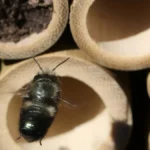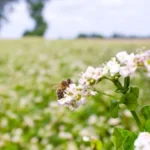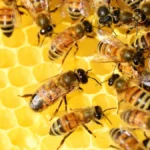Why Solitary Bee Hotels Matter for Homestead Beekeeping
Every human being who cares about the planet should aim to create bee-friendly gardens and yards with the inclusion of Bee Hotels. Bees are extremely important to our planet. They help pollinate plants and without them, many of our favorite foods would cease to exist.
Not everyone can maintain beehives or look after large bee colonies. However, most of us can build solitary bee houses or bee hotels to support solitary bees. Solitary bees and wasps are as important as colonies of bees. They help pollinate plants and maintain the biodiversity. By building safe nesting places for them, like bee hotels and solitary bee houses, we can all contribute to saving declining bee populations.
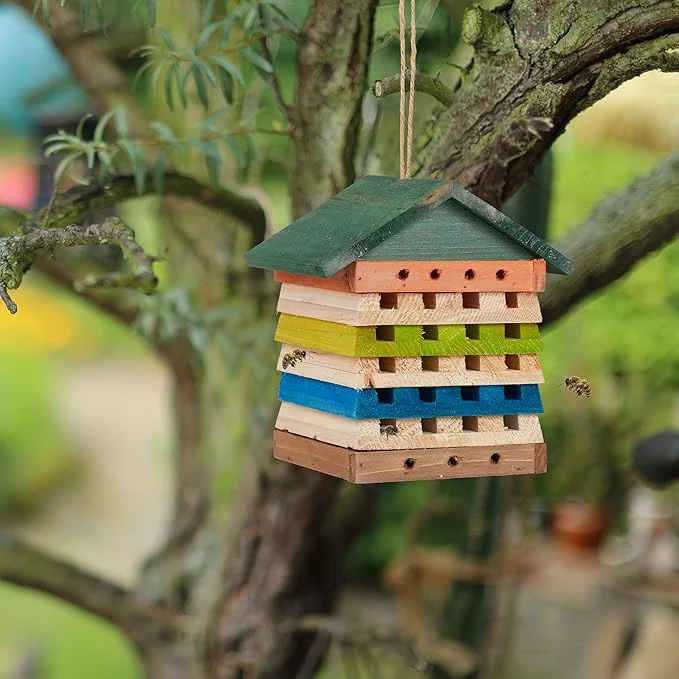
How to Create Effective Solitary Bee Habitats and Hotels
As mentioned before, solitary bees and wasps are as important as bee colonies. They are important pollinators and gardener’s friends.
By providing bee hotels and solitary bee houses, you can make sure that these lone warriors get a safe nesting and resting habitat. These days, you can buy sturdy solitary bee houses and nests from the market. However, if you opt to take the DIY route, you can easily craft these nests and provide comfortable, budget-friendly, and safe-nesting habitats for lone bees.
DIY bee hotels are a fun activity you can do with your kids. This is a fun, satisfying, and rewarding project for the entire family. Use the following steps to help you create a bee-friendly habitat in your yard.
1. Design Your DIY Bee Hotel: Plans and Considerations
Start by making a rough sketch or outline of the Bee Hotel. It can be as simple or complex as you like depending on your expertise in crafting projects.
2. Essential Materials for Building Successful Bee Hotels
If you decide to fashion the solitary bee house from everyday household items, you need the following:
- Empty milk cartons
- Pipes or off cut bamboo
- Plastic containers or buckets.
Alternatively, you can make the bee house with wood. Simple, untreated wood is the best. If you opt to paint the wood, wait for a few days for the paint to dry before hanging it as bees hate the scent of paint.
If you opt to use containers, clean and dry them thoroughly to remove leftover milk/food from them. This is a great way to reuse, repurpose, and recycle these items. It is especially a great way to teach children about sustainability.
3. Best Bee-Safe Nesting Materials for DIY Solitary Bee Houses
Solitary bees need nesting materials in their resting areas. They use these materials to create their nests. Choose nesting materials that will deter pathogens and also protect the bees from mold.
You can buy ready-to-use nesting materials made from wood or reeds or simply collect and mix and match nesting materials readily found in our homes and gardens. These include:
- Paper/cardboard – cut them into tubes that fit in your bee hotel
- Hollow plant stems (use plants like asters, bee balm, etc)
- Pine/spruce/cedar/oak wooden blocks. Drill holes uniformly in these.
Line the drilled wood/stems with newspaper if possible. Make sure the chosen materials are devoid of splinters and sharp edges. Smooth down the nesting materials to prevent hurting the bees. Store-brought, reusable wood trays are a great option as you can reuse them over and over. They are also easy to clean.
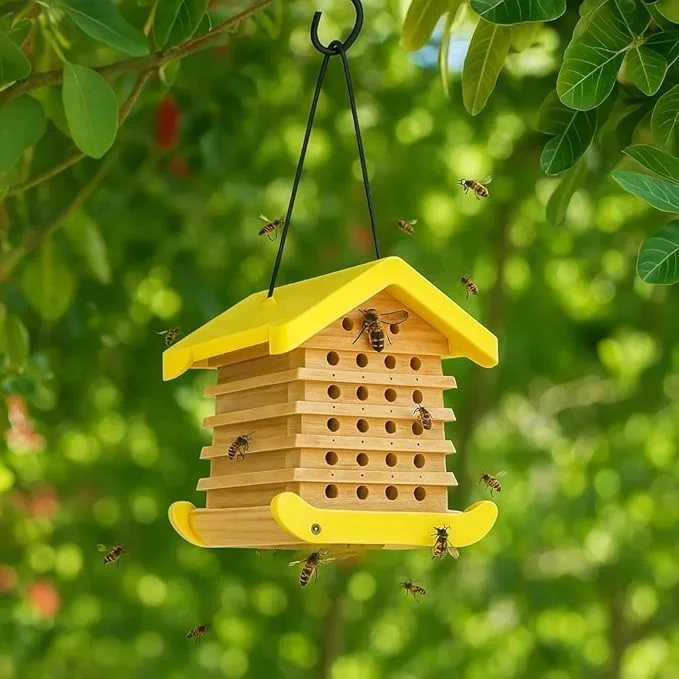
Nesting Materials to Avoid in Your Homestead Bee Hotel
Avoid plastic straws as they are not biodegradable and sustainable. Similarly, avoid bamboo reeds as they are too large for most bee species.
Expert Tips for Drilling Perfect Holes in Wood for Bee Habitats
- If you opt for untreated wood, drill holes of varying sizes to attract different bee species.
- Do not drill through – leave the back side of the tubular structures closed.
- Don’t forget to add paper inserts in drilled blocks to prevent pathogens.
Adding Color: How to Make Your Bee Hotels Attractive to Pollinators
Bees love color and are attracted to it. You can do any or all of the following to make your solitary bee home colorful and attractive to bees:
- Paint it- but do make sure there is no strong smell as bees are repelled by it. Yellow, blue, and pink are some great color choices.
- Stick some beads or sequins on the Bee Hotel
- Get your kids to draw colorful pictures on it.
Strategic Placement: Choosing the Ideal Location for Your Bee Hotels
A good location for your bee hotel will make the bees feel welcome. Bees are cold-blooded so they prefer hotels facing the morning sun to keep warm.
Ideally, south-facing or southeast-facing spots in the garden are good locations for your bee hotel. Place the bee hotel or solitary bee house in/near areas having plenty of flowers/blooms. (Check out the next point regarding planting the best flowers for attracting bees.)
- Do not let your solitary bee house sway too much- place it on solid footing.
- Keep it at eye level – about 5 feet from the ground. This protects them from predators.
- Do not let vegetation block the entrance to the hotel.
Avoid using pesticides near the hotel as these repel bees.

Top Bee-Friendly Plants for Your Homestead Garden
The easiest way to attract bees to your bee-friendly habitats is to plant the bee-friendly plants in your garden. Start with native plants which are attractive to local pollinators like bees and wasps. Native plants also grow best in the local soil and climate and are a great way to create a welcoming garden for bees.
Bees will appreciate plants that flower all year round. You can also choose plants with varying bloom times and plant them alongside annuals and perennials. Some perennials also have multiple bloom times and extended bloom seasons. Talk to experts from local bee farms near me or check out this pollinator guide to learn about the best bee-friendly plants available in your region.
Here are some examples of plants that bees love the most:
- Bee balm
- Purple coneflower
- Joe-Pye weed
- Wildflowers
Bees also love alfalfa, clover, echinacea, snapdragon, berries, sunflowers, daisies, zinnias, and asters.
If you want more information on plants to grow for on a beekeeping homestead, you can read our article about The Best Wildflowers to Plant on a Homestead for Bees
Proper Maintenance: How to Monitor Your Solitary Bee Habitat
Ensure that the bees are safe from predatory birds, spiders, and ants. Monitor the bee and bee hotel and ensure there is no moisture or mold forming on the walls of the observation hive.
We hope this brief guide inspires you to create a safe and bee-friendly habitat and nesting area for solitary bees.
If you don’t have the time, perhaps check out some ready made designs. Here are a few that we found work really well with a balance between cost, function and design aesthetics for an amazing bee hotel.
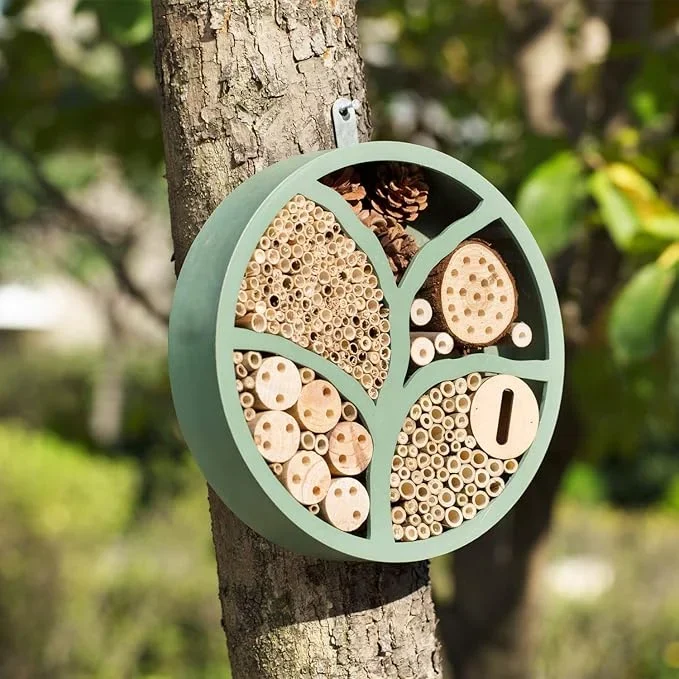
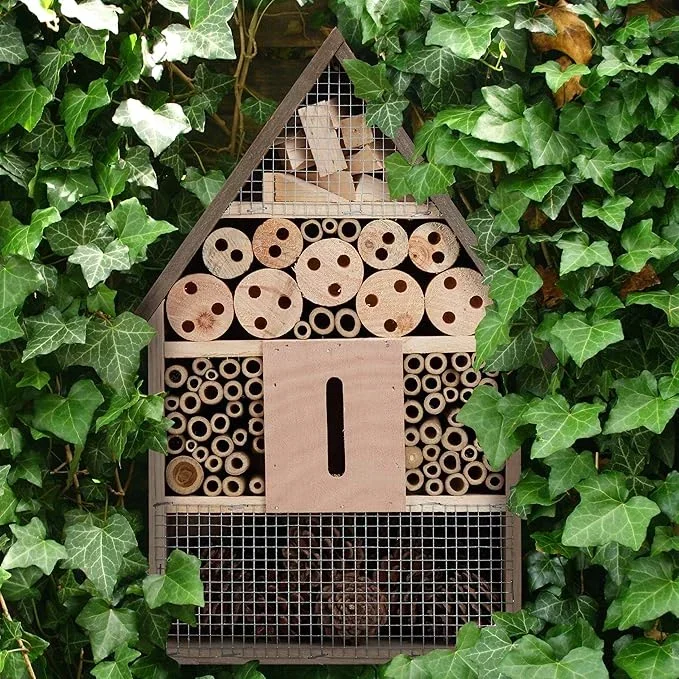
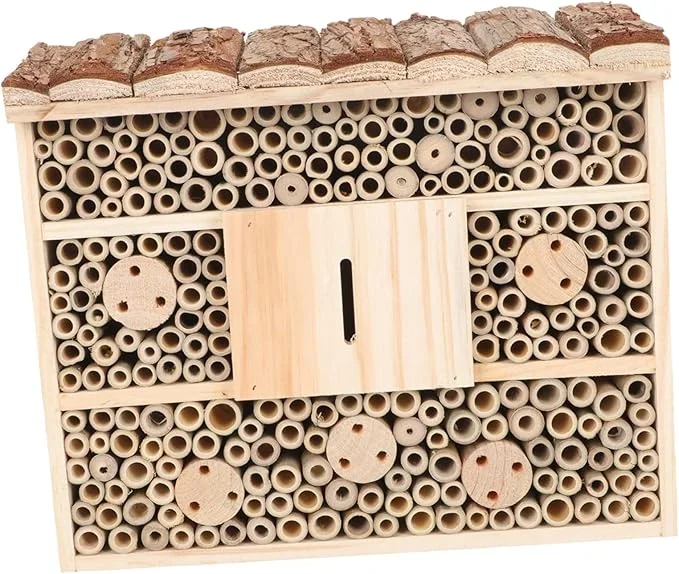
Solitary Bee Hotel FAQs: Everything Homesteaders Need to Know
What is a bee hotel, and why is it important?
A bee hotel is a structure designed to provide nesting sites for solitary bees. It’s essential for supporting pollination and biodiversity, especially as natural habitats decline.
What materials can I use to build a bee hotel?
You can use untreated wood, hollow plant stems, paper tubes, or reusable wood trays. Avoid plastic, bamboo, or materials with sharp edges to keep it bee-safe.
Where should I place my bee hotel?
Choose a sunny, south or southeast-facing location, at eye level (about 5 feet off the ground), away from pesticides and protected from wind or predators.
What types of bees use bee hotels?
Solitary bees, such as mason bees and leafcutter bees, commonly use bee hotels. These bees do not live in colonies and require individual nesting spaces.
What plants attract solitary bees to my garden?
Plant native flowers like bee balm, coneflowers, wildflowers, and sunflowers. Include blooms with staggered flowering times for year-round nectar and pollen.
Can children help build bee hotels?
Yes! Building bee hotels is a fun and educational project for kids, teaching sustainability and the importance of pollinators while fostering creativity.
How do I prevent pathogens in my bee hotel?
Use smooth, splinter-free nesting materials and line drilled wood holes with paper. Replace old materials annually to maintain cleanliness and safety.
How can I decorate my bee hotel to attract bees?
Bees are drawn to colors like yellow, blue, and pink. Paint your bee hotel in these shades with non-toxic paint and add fun decorations like beads or drawings.
How do I protect my bee hotel from predators?
Keep vegetation from blocking entrances, secure the structure to prevent swaying, and place it in a location that’s difficult for ants, spiders, or birds to reach.
How often should I monitor my bee hotel?
Check periodically to ensure it’s clean, dry, and free of mold or predators. Replace any worn nesting materials and avoid disturbing the bees unnecessarily.

Sam Fielding is an apiary student at The Ohio State University with a strong passion for beekeeping and honey production. Dedicated to advancing the resilience of bees, Sam is actively involved in establishing bee colonies in the lower regions of the United States, including Texas and Florida, as part of a volunteer program. His hands-on experience in these diverse climates has given him a unique perspective on bee health and hive management.
Sam’s dedication to both the scientific and ethical aspects of beekeeping makes him a valuable voice in the apiculture community, advocating for both bee health and consumer rights. He also helps us maintain our facebook page, so feel free to get in touch with him there!

